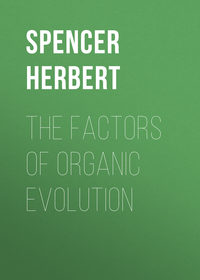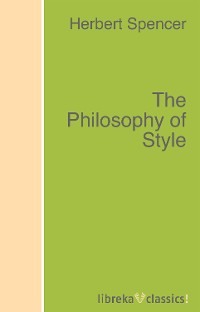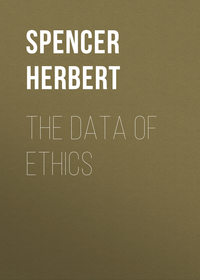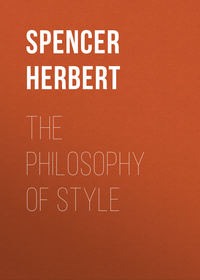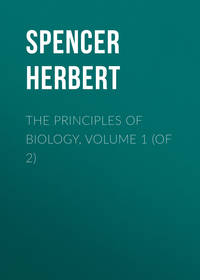 полная версия
полная версияFirst Principles
Thus while the Solar System, if evolved from diffused matter, has illustrated the law of equilibration in the establishment of a complete moving equilibrium; and while, as at present constituted, it illustrates the law of equilibration in the balancing of all its movements; it also illustrates this law in the processes which astronomers and physicists infer are still going on. That motion of masses produced during Evolution, is being slowly re-diffused in molecular motion of the ethereal medium; both through the progressive integration of each mass, and the resistance to its motion through space. Infinitely remote as may be the state when all the motions of masses shall be transformed into molecular motion, and all the molecular motion equilibrated; yet such a state of complete integration and complete equilibration, is that towards which the changes now going on throughout the Solar System inevitably tend.
§ 132. A spherical figure is the one which can alone equilibrate the forces of mutually-gravitating atoms. If the aggregate of such atoms has a rotatory motion, the form of equilibrium becomes a spheroid of greater or less oblateness, according to the rate of rotation; and it has been ascertained that the Earth is an oblate spheroid, diverging just as much from sphericity as is requisite to counterbalance the centrifugal force consequent on its velocity round its axis. That is to say, during the evolution of the Earth, there has been reached a complete equilibrium of those forces which affect its general outline. The only other process of equilibration which the Earth as a whole can exhibit, is the loss of its axial motion; and that any such loss is going on, we have no direct evidence. It has been contended, however, by Prof. Helmholtz, that inappreciable as may be its effect within known periods of time, the friction of the tidal wave must be slowly diminishing the Earth’s rotatory motion, and must eventually destroy it. Now though it seems an oversight to say that the Earth’s rotation can thus be destroyed, since the extreme effect, to be reached only in infinite time by such a process, would be an extension of the Earth’s day to the length of a lunation; yet it seems clear that this friction of the tidal wave is a real cause of decreasing rotation. Slow as its action is, we must recognize it as exemplifying, under another form, the universal progress towards equilibrium.
It is needless to point out, in detail, how those movements which the Sun’s rays generate in the air and water on the Earth’s surface, and through them in the Earth’s solid substance,20 one and all teach the same general truth. Evidently the winds and waves and streams, as well as the denudations and depositions they effect, perpetually illustrate on a grand scale, and in endless modes, that gradual dissipation of motions described in the first section; and the consequent tendency towards a balanced distribution of forces. Each of these sensible motions, produced directly or indirectly by integration of those insensible motions communicated from the Sun, becomes, as we have seen, divided and subdivided into motions less and less sensible; until it is finally reduced to insensible motions, and radiated from the Earth in the shape of thermal undulations. In their totality, these complex movements of aerial, liquid, and solid matter on the Earth’s crust, constitute a dependent moving equilibrium. As we before saw, there is traceable throughout them an involved combination of rhythms. The unceasing circulation of water from the ocean to the land, and from the land back to the ocean, is a type of these various compensating actions; which, in the midst of all the irregularities produced by their mutual interferences, maintain an average. And in this, as in other equilibrations of the third order, we see that the power from moment to moment in course of dissipation, is from moment to moment renewed from without: the rises and falls in the supply, being balanced by rises and falls in the expenditure; as witness the correspondence between the magnetic variations and the cycle of the solar spots. But the fact it chiefly concerns us to observe, is, that this process must go on bringing things ever nearer to complete rest. These mechanical movements, meteorologic and geologic, which are continually being equilibrated, both temporarily by counter-movements and permanently by the dissipation of such movements and counter-movements, will slowly diminish as the quantity of force received from the Sun diminishes. As the insensible motions propagated to us from the centre of our system become feebler, the sensible motions here produced by them must decrease; and at that remote period when the solar heat has ceased to be appreciable, there will no longer be any appreciable re-distributions of matter on the surface of our planet.
Thus from the highest point of view, all terrestrial changes are incidents in the course of cosmical equilibration. It was before pointed out, (§ 80) that of the incessant alterations which the Earth’s crust and atmosphere undergo, those which are not due to the still-progressing motion of the Earth’s substance towards its centre of gravity, are due to the still-progressing motion of the Sun’s substance towards its centre of gravity. Here it is to be remarked, that this continuance of integration in the Earth and in the Sun, is a continuance of that transformation of sensible motion into insensible motion which we have seen ends in equilibration; and that the arrival in each case at the extreme of integration, is the arrival at a state in which no more sensible motion remains to be transformed into insensible motion – a state in which the forces producing integration and the forces opposing integration, have become equal.
§ 133. Every living body exhibits, in a four-fold form, the process we are tracing out – exhibits it from moment to moment in the balancing of mechanical forces; from hour to hour in the balancing of functions; from year to year in the changes of state that compensate changes of condition; and finally in the complete arrest of vital movements at death. Let us consider the facts under these heads.
The sensible motion constituting each visible action of an organism, is soon brought to a close by some adverse force within or without the organism. When the arm is raised, the motion given to it is antagonized partly by gravity and partly by the internal resistances consequent on structure; and its motion, thus suffering continual deduction, ends when the arm has reached a position at which the forces are equilibrated. The limits of each systole and diastole of the heart, severally show us a momentary equilibrium between muscular strains that produce opposite movements; and each gush of blood requires to be immediately followed by another, because the rapid dissipation of its momentum would otherwise soon bring the mass of circulating fluid to a stand. As much in the actions and re-actions going on among the internal organs, as in the mechanical balancing of the whole body, there is at every instant a progressive equilibration of the motions at every instant produced. Viewed in their aggregate, and as forming a series, the organic functions constitute a dependent moving equilibrium – a moving equilibrium, of which the motive power is ever being dissipated through the special equilibrations just exemplified, and is ever being renewed by the taking in of additional motive power. Food is a store of force which continually adds to the momentum of the vital actions, as much as is continually deducted from them by the forces overcome. All the functional movements thus maintained, are, as we have seen, rhythmical (§ 96); by their union compound rhythms of various lengths and complexities are produced; and in these simple and compound rhythms, the process of equilibration, besides being exemplified at each extreme of every rhythm, is seen in the habitual preservation of a constant mean, and in the re-establishment of that mean when accidental causes have produced divergence from it. When, for instance, there is a great expenditure of motion through muscular activity, there arises a re-active demand on those stores of latent motion which are laid up in the form of consumable matter throughout the tissues: increased respiration and increased rapidity of circulation, are instrumental to an extra genesis of force, that counter-balances the extra dissipation of force. This unusual transformation of molecular motion into sensible motion, is presently followed by an unusual absorption of food – the source of molecular motion; and in proportion as there has been a prolonged draft upon the spare capital of the system, is there a tendency to a prolonged rest, during which that spare capital is replaced. If the deviation from the ordinary course of the functions has been so great as to derange them, as when violent exertion produces loss of appetite and loss of sleep, an equilibration is still eventually effected. Providing the disturbance is not such as to overturn the balance of the functions, and destroy life (in which case a complete equilibration is suddenly effected), the ordinary balance is by and by re-established: the returning appetite is keen in proportion as the waste has been large; while sleep, sound and prolonged, makes up for previous wakefulness. Not even in those extreme cases where some excess has wrought a derangement that is never wholly rectified, is there an exception to the general law; for in such cases the cycle of the functions is, after a time, equilibrated about a new mean state, which thenceforth becomes the normal state of the individual. Thus, among the involved rhythmical changes constituting organic life, any disturbing force that works an excess of change in some direction, is gradually diminished and finally neutralized by antagonistic forces; which thereupon work a compensating change in the opposite direction, and so, after more or less of oscillation, restore the medium condition. And this process it is, which constitutes what physicians call the vis medicatrix naturæ. The third form of equilibration displayed by organic bodies, is a necessary sequence of that just illustrated. When through a change of habit or circumstance, an organism is permanently subject to some new influence, or different amount of an old influence, there arises, after more or less disturbance of the organic rhythms, a balancing of them around the new average condition produced by this additional influence. As temporary divergences of the organic rhythms are counteracted by temporary divergences of a reverse kind; so there is an equilibration of their permanent divergences by the genesis of opposing divergences that are equally permanent. If the quantity of motion to be habitually generated by a muscle, becomes greater than before, its nutrition becomes greater than before. If the expenditure of the muscle bears to its nutrition, a greater ratio than expenditure bears to nutrition in other parts of the system; the excess of nutrition becomes such that the muscle grows. And the cessation of its growth is the establishment of a balance between the daily waste and the daily repair – the daily expenditure of force, and the amount of latent force daily added. The like must manifestly be the case with all organic modifications consequent on change of climate or food. This is a conclusion which we may safely draw without knowing the special re-arrangements that effect the equilibration. If we see that a different mode of life is followed, after a period of functional derangement, by some altered condition of the system – if we see that this altered condition, becoming by and by established, continues without further change; we have no alternative but to say, that the new forces brought to bear on the system, have been compensated by the opposing forces they have evoked. And this is the interpretation of the process which we call adaptation. Finally, each organism illustrates the law in the ensemble of its life. At the outset it daily absorbs under the form of food, an amount of force greater than it daily expends; and the surplus is daily equilibrated by growth. As maturity is approached, this surplus diminishes; and in the perfect organism, the day’s absorption of potential motion balances the day’s expenditure of actual motion. That is to say, during adult life, there is continuously exhibited an equilibration of the third order. Eventually, the daily loss, beginning to out-balance the daily gain, there results a diminishing amount of functional action; the organic rhythms extend less and less widely on each side of the medium state; and there finally results that complete equilibration which we call death.
The ultimate structural state accompanying that ultimate functional state towards which an organism tends, both individually and as a species, may be deduced from one of the propositions set down in the opening section of this chapter. We saw that the limit of heterogeneity is arrived at whenever the equilibration of any aggregate becomes complete – that the re-distribution of matter can continue so long only as there continues any motion unbalanced. Whence we found it to follow that the final structural arrangements, must be such as will meet all the forces acting on the aggregate, by equivalent antagonist forces. What is the implication in the case of organic aggregates; the equilibrium of which is a moving one? We have seen that the maintenance of such a moving equilibrium, requires the habitual genesis of internal forces corresponding in number, directions, and amounts to the external incident forces – as many inner functions, single or combined, as there are single or combined outer actions to be met. But functions are the correlatives of organs; amounts of functions are, other things equal, the correlatives of sizes of organs; and combinations of functions the correlatives of connections of organs. Hence the structural complexity accompanying functional equilibration, is definable as one in which there are as many specialized parts as are capable, separately and jointly, of counteracting the separate and joint forces amid which the organism exists. And this is the limit of organic heterogeneity; to which man has approached more nearly than any other creature.
Groups of organisms display this universal tendency towards a balance very obviously. In § 96, every species of plant and animal was shown to be perpetually undergoing a rhythmical variation in number – now from abundance of food and absence of enemies rising above its average; and then by a consequent scarcity of food and abundance of enemies being depressed below its average. And here we have to observe that there is thus maintained an equilibrium between the sum of those forces which result in the increase of each race, and the sum of those forces which result in its decrease. Either limit of variation is a point at which the one set of forces, before in excess of the other, is counterbalanced by it. And amid these oscillations produced by their conflict, lies that average number of the species at which its expansive tendency is in equilibrium with surrounding repressive tendencies. Nor can it be questioned that this balancing of the preservative and destructive forces which we see going on in every race, must necessarily go on. Since increase of number cannot but continue until increase of mortality stops it; and decrease of number cannot but continue until it is either arrested by fertility or extinguishes the race entirely.
§ 134. The equilibrations of those nervous actions which constitute what we know as mental life, may be classified in like manner with those which constitute what we distinguish as bodily life. We may deal with them in the same order.
Each pulse of nervous force from moment to moment generated, (and it was shown in § 97 that nervous currents are not continuous but rhythmical) is met by counteracting forces; in overcoming which it is dispersed and equilibrated. When tracing out the correlation and equivalence of forces, we saw that each sensation and emotion, or rather such part of it as remains after the excitation of associated ideas and feelings, is expended in working bodily changes – contractions of the involuntary muscles, the voluntary muscles, or both; as also in a certain stimulation of secreting organs. That the movements thus initiated are ever being brought to a close by the opposing forces they evoke, was pointed out above; and here it is to be observed that the like holds with the nervous changes thus initiated. Various facts prove that the arousing of a thought or feeling, always involves the overcoming of a certain resistance: instance the fact that where the association of mental states has not been frequent, a sensible effort is needed to call up the one after the other; instance the fact that during nervous prostration there is a comparative inability to think – the ideas will not follow one another with the habitual rapidity; instance the converse fact that at times of unusual energy, natural or artificial, the friction of thought becomes relatively small, and more numerous, more remote, or more difficult connections of ideas are formed. That is to say, the wave of nervous energy each instant generated, propagates itself throughout body and brain, along those channels which the conditions at the instant render lines of least resistance; and spreading widely in proportion to its amount, ends only when it is equilibrated by the resistances it everywhere meets. If we contemplate mental actions us extending over hours and days, we discover equilibrations analogous to those hourly and daily established among the bodily functions. In the one case as in the other, there are rhythms which exhibit a balancing of opposing forces at each extreme, and the maintenance of a certain general balance. This is seen in the daily alternation of mental activity and mental rest – the forces expended during the one being compensated by the forces acquired during the other. It is also seen in the recurring rise and fall of each desire: each desire reaching a certain intensity, is equilibrated either by expenditure of the force it embodies, in the desired actions, or, less completely, in the imagination of such actions: the process ending in that satiety, or that comparative quiescence, forming the opposite limit of the rhythm. And it is further manifest under a two-fold form, on occasions of intense joy or grief: each paroxysm of passion, expressing itself in vehement bodily actions, presently reaches an extreme whence the counteracting forces produce a return to a condition of moderate excitement; and the successive paroxysms finally diminishing in intensity, end in a mental equilibrium either like that before existing, or partially differing from it in its medium state. But the species of mental equilibration to be more especially noted, is that shown in the establishment of a correspondence between relations among our states of consciousness and relations in the external world. Each outer connection of phenomena which we are capable of perceiving, generates, through accumulated experiences, an inner connection of mental states; and the result towards which this process tends, is the formation of a mental connection having a relative strength that answers to the relative constancy of the physical connection represented. In conformity with the general law that motion pursues the line of least resistance, and that, other things equal, a line once taken by motion is made a line that will be more readily pursued by future motion; we have seen that the ease with which nervous impressions follow one another, is, other things equal, great in proportion to the number of times they have been repeated together in experience. Hence, corresponding to such an invariable relation as that between the resistance of an object and some extension possessed by it, there arises an indissoluble connection in consciousness; and this connection, being as absolute internally as the answering one is externally, undergoes no further change – the inner relation is in perfect equilibrium with the outer relation. Conversely, it hence happens that to such uncertain relations of phenomena as that between clouds and rain, there arise relations of ideas of a like uncertainty; and if, under given aspects of the sky, the tendencies to infer fair or foul weather, correspond to the frequencies with which fair or foul weather follow such aspects, the accumulation of experiences has balanced the mental sequences and the physical sequences. When it is remembered that between these extremes there are countless orders of external connections having different degrees of constancy, and that during the evolution of intelligence there arise answering internal associations having different degrees of cohesion; it will be seen that there is a progress towards equilibrium between the relations of thought and the relations of things. This equilibration can end only when each relation of things has generated in us a relation of thought, such that on the occurrence of the conditions, the relation in thought arises as certainly as the relation in things. Supposing this state to be reached (which however it can be only in infinite time) experience will cease to produce any further mental evolution – there will have been reached a perfect correspondence between ideas and facts; and the intellectual adaptation of man to his circumstances will be complete. The like general truths are exhibited in the process moral of adaptation; which is a continual approach to equilibrium between the emotions and the kinds of conduct necessitated by surrounding conditions. The connections of feelings and actions, are determined in the same way as the connections of ideas: just as repeating the association of two ideas, facilitates the excitement of the one by the other; so does each discharge of feeling into action, render the subsequent discharge of such feeling into such action more easy. Hence it happens that if an individual is placed permanently in conditions which demand more action of a special kind than has before been requisite, or than is natural to him – if the pressure of the painful feelings which these conditions entail when disregarded, impels him to perform this action to a greater extent – if by every more frequent or more lengthened performance of it under such pressure, the resistance is somewhat diminished; then, clearly, there is an advance towards a balance between the demand for this kind of action and the supply of it. Either in himself, or in his descendants continuing to live under these conditions, enforced repetition must eventually bring about a state in which this mode of directing the energies will be no more repugnant than the various other modes previously natural to the race. Hence the limit towards which emotional modification perpetually tends, and to which it must approach indefinitely near (though it can absolutely reach it only in infinite time) is a combination of desires that correspond to all the different orders of activity which the circumstances of life call for – desires severally proportionate in strength to the needs for these orders of activity; and severally satisfied by these orders of activity. In what we distinguish as acquired habits, and in the moral differences of races and nations produced by habits that are maintained through successive generations, we have countless illustrations of this progressive adaptation; which can cease only with the establishment of a complete equilibrium between constitution and conditions.
Possibly some will fail to see how the equilibrations described in this section, can be classed with those preceding them; and will be inclined to say that what are here set down as facts, are but analogies. Nevertheless such equilibrations are as truly physical as the rest. To show this fully, would require a more detailed analysis than can now be entered on. For the present it must suffice to point out, as before (§ 82), that what we know subjectively as states of consciousness, are, objectively, modes of force; that so much feeling is the correlate of so much motion; that the performance of any bodily action is the transformation of a certain amount of feeling into its equivalent amount of motion; that this bodily action is met by forces which it is expended in overcoming; and that the necessity for the frequent repetition of this action, implies the frequent recurrence of forces to be so overcome. Hence the existence in any individual of an emotional stimulus that is in equilibrium with certain external requirements, is literally the habitual production of a certain specialized portion of nervous energy, equivalent in amount to a certain order of external resistances that are habitually met. And thus the ultimate state, forming the limit towards which Evolution carries us, is one in which the kinds and quantities of mental energy daily generated and transformed into motions, are equivalent to, or in equilibrium with, the various orders and degrees of surrounding forces which antagonize such motions.




